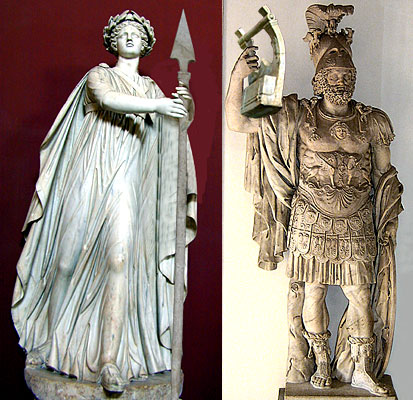Ovid, Amores I.1, 3, 9, 11, 12; III.15

Role Reversal, Ovidian Style
- Let us begin at the end, with poem III.15. Do you think this poem provides a fitting close for the Amores; why or why not? What metaphor is suggested by the phrase raditur haec elegis ultima meta meis (line 2)?
This image provides a clue. How does this poem refer back to I.1, the poem which begins the collection? What Muse does Ovid invoke in line 19, and why does he call her genialis? A clue is provided by the epitaph that Ovid composed for his own tomb, writing from exile in Tristia III.3.73-74:
hic ego qui iaceo tenerorum lusor amorum ingenio perii Naso poeta meo. - I.1: What is the primary metaphor of this poem and how does it relate to the Roman conception of poetic genre? Why does Ovid begin his first line with Arma? Ovid says that poets belong to the Muses (as depicted on this Roman sarcophagus); what is the literal meaning of turba and what is the effect of using it here? What concept of the gods underlies the series of role reversals in lines 5-14 (hint: note the words iuris, regnare, lege, regna)? Describe the reversals. Why does Ovid conclude with the reversal depicted in the images above? What is the poet's final conclusion about Cupid? Since the poet is stuck with the elegiac meter, what does he say he lacks, and how does Cupid remedy this lack? What does this tell us about the way Ovid will treat love in the poems that follow? What specific Muse does Ovid invoke at the end of the poem? What does per undenos emodulanda pedes (line 30) mean and how does it return us to the beginning of the poem (the technique of "ring composition")?
- I.3: In this poem Ovid portrays himself as the typical elegiac lover. What are the main qualities of this lover? What metaphor underlies the phrase non sum desultor amoris (line 15) and how effective is it? Does this poem convey a sense of sincerity, or does it seem rather tongue in cheek? (Note that Ovid includes a parallel poem, II.4, that is the direct opposite of this one and could be summed up with the modern song lyric "When I'm not near the girl I love, I love the girl I'm near.")
- I.9: This whole poem is built on a single metaphor; describe it and explain all the points of comparison that Ovid brings out. Do you think this is an appropriate comparison? How does it relate to poems I.1 and III.15?
- I.11 and 12: Why is it appropriate that these two poems are "tied together" (see this image for a clue, and the word duplices in line 27). How does Ovid's attitude toward the tabellae change throughout the two poems, and how are the tablets and the maidservant, Nape, linked?
- Explain your overall opinion of the Amores of Ovid.